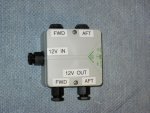bitman
Well-Known Member
I like your soldering station, it makes mine look a real cheapie!
thx, i bought it some where in the 80s.
I like your soldering station, it makes mine look a real cheapie!
The cable supplied by Jaycar has been left uncut...
still do play with electronics as i'm a freelance sound engineer and also like modifiying things (like mod a scanner to make it an ais receiver)....
@bitman: I like your "helping hands" unit, where did you get it?ready to start building
The cable is much longer than I expected, which bodes well for the dual unit I'm considering designing.
I'd be interested in knowing the cable length, and the size of the conductors. Do you have a micrometer or vernier/digital caliper? The diameter of a single strand, and their number would be very useful.
Also, are there any markings on the transducers - probably to late for Norman to answer!

@bitman: this is also a project I'm considering. Could you PM me if you have any info, or perhaps a new thread (with a PM "heads-up" if you could)?
@bitman: I like your "helping hands" unit, where did you get it?
PS Say "Hi" to Tux for me


Just got the letter from Parcelfarce asking for £35 so it looks like I have not had to pay any additional postage from Australia. Ordered on the 4th Jan here today, not bad. Should be able to start building this weekend.
I wonder if somebody who has got it's kit ready, could measure and post here the actual Amp consumption @ 12VDC.
I connected a multi meter, and could not get a reading on the amps scale. It is no use trying to read resistance without a battery connected as resistance simply drops slowly away once you connect the meter. The article states that continuous power drain is three watts or less.
I wonder if somebody who has got it's kit ready, could measure and post here the actual Amp consumption @ 12VDC.
With 3 Watts expected power drain, you should be able to measure 0.25 Amp, correct? 0.25 Amp is good for battery life, but should 3 Watts be enough to kill algae, with all the losses from penetrating the hull? Other manufacturer claim to produce around 15 Watts, with pick current draw of up to 3 Amp. Which is not good for battery life on the other hand, unless you install a solar panel.




